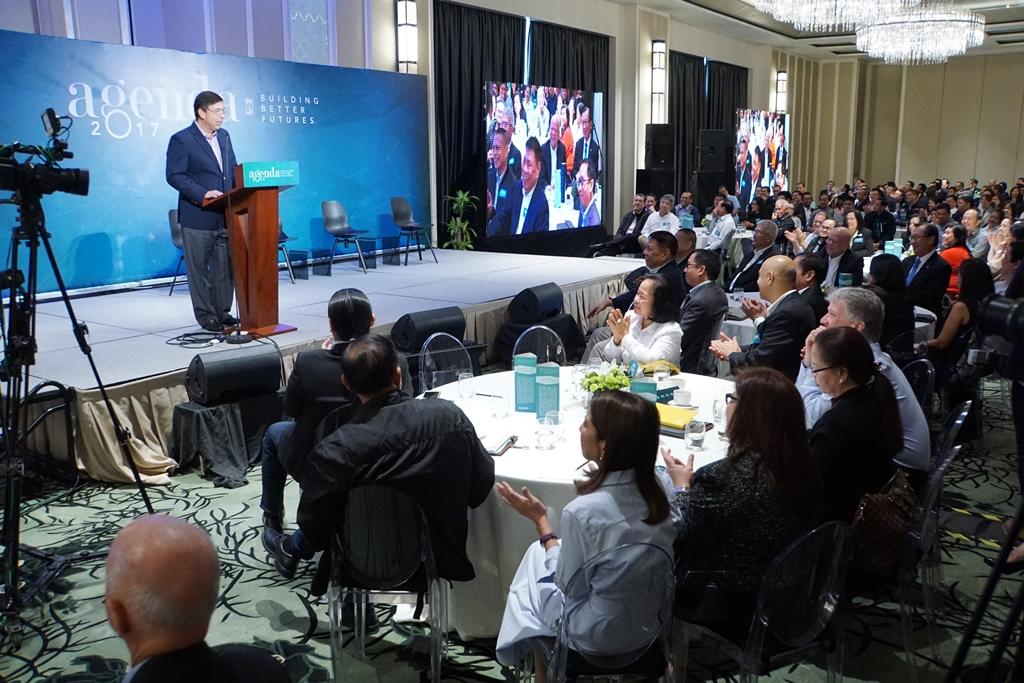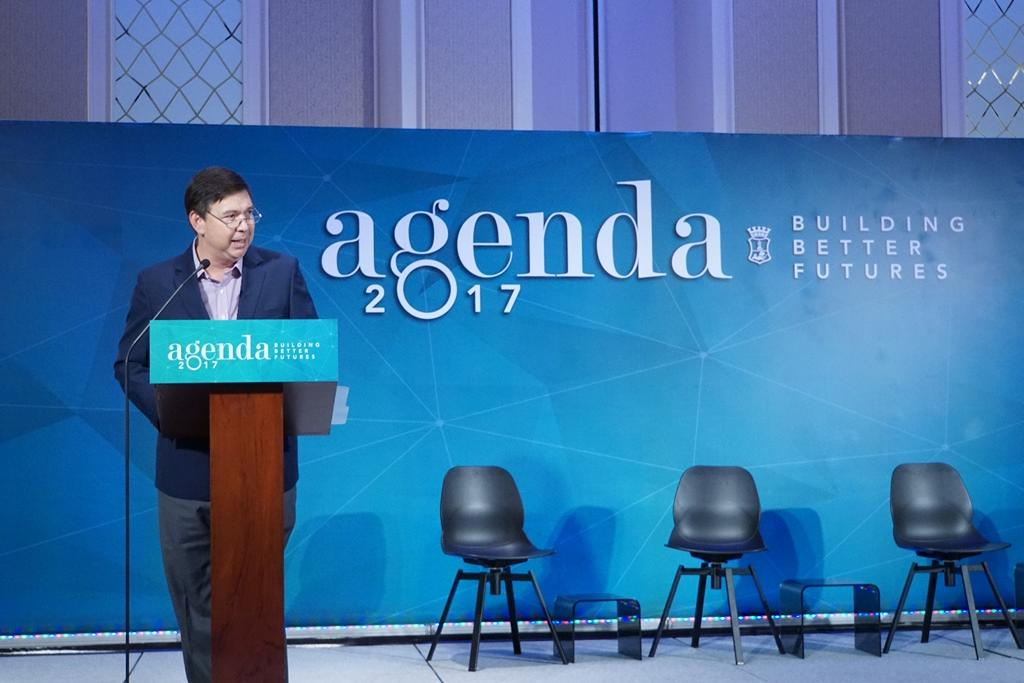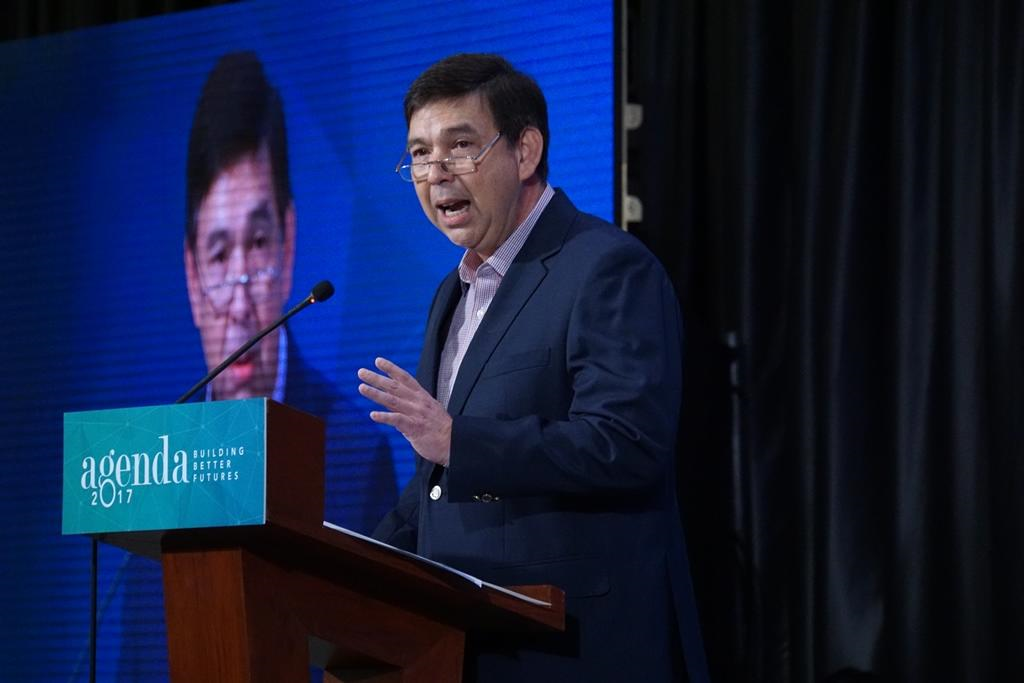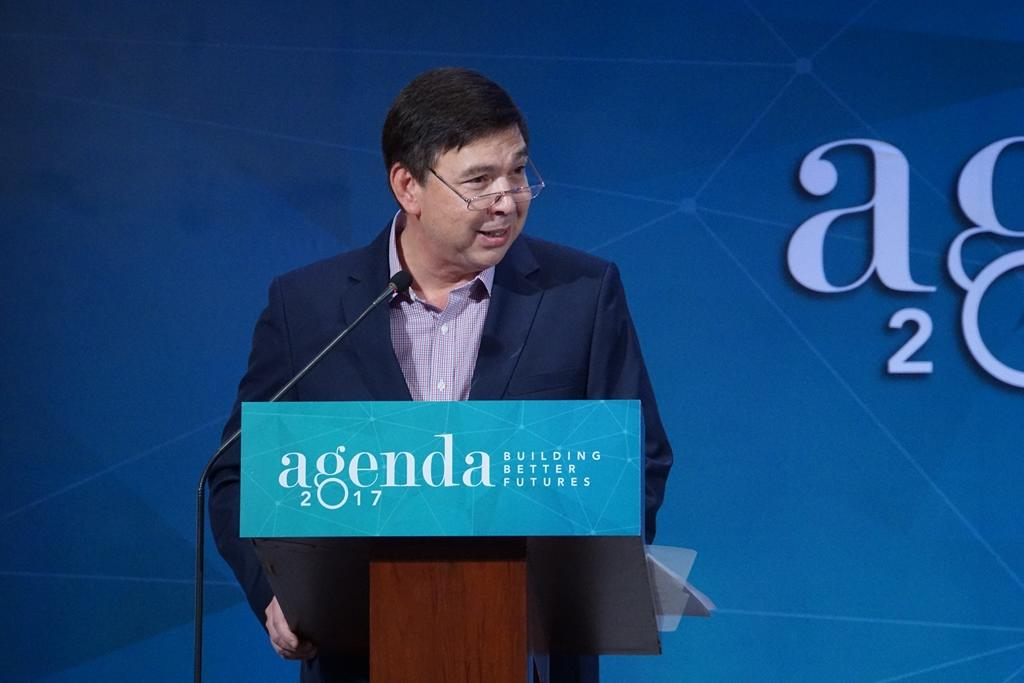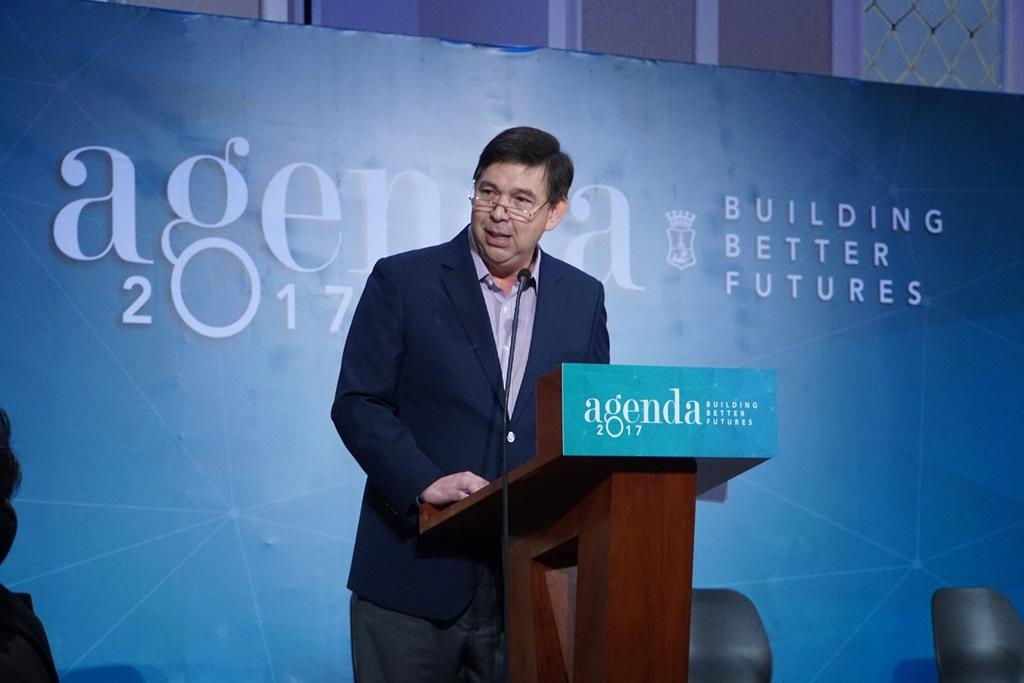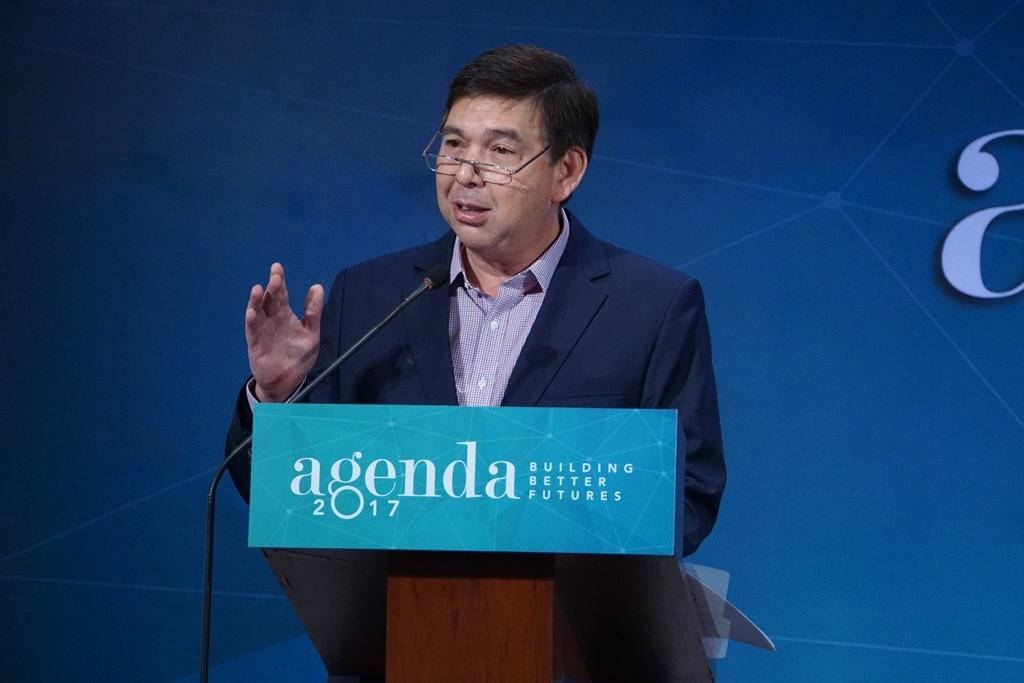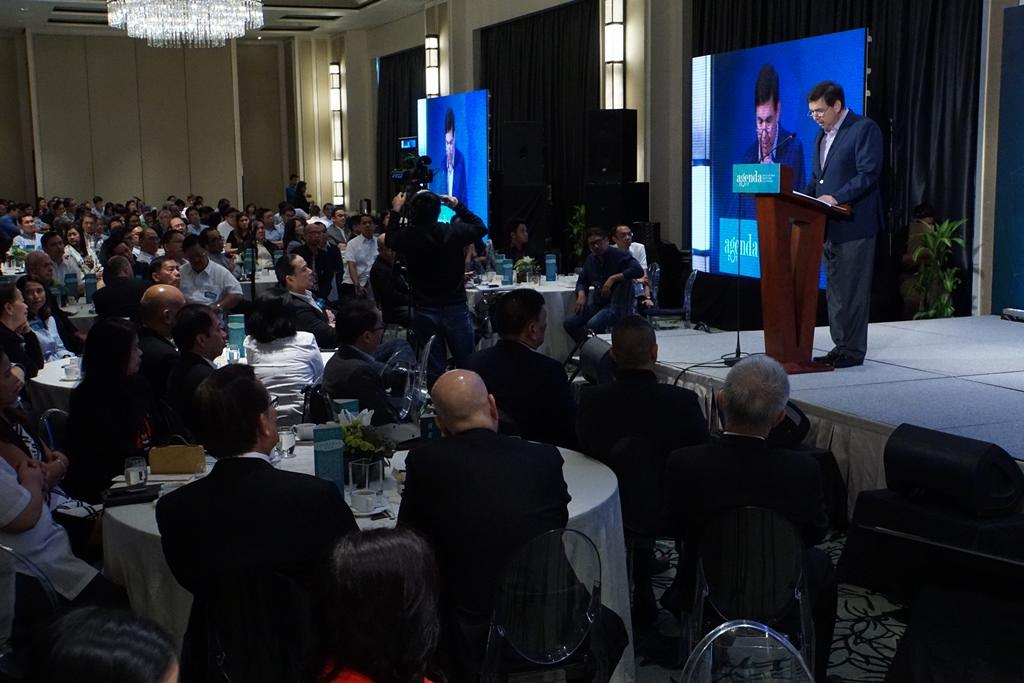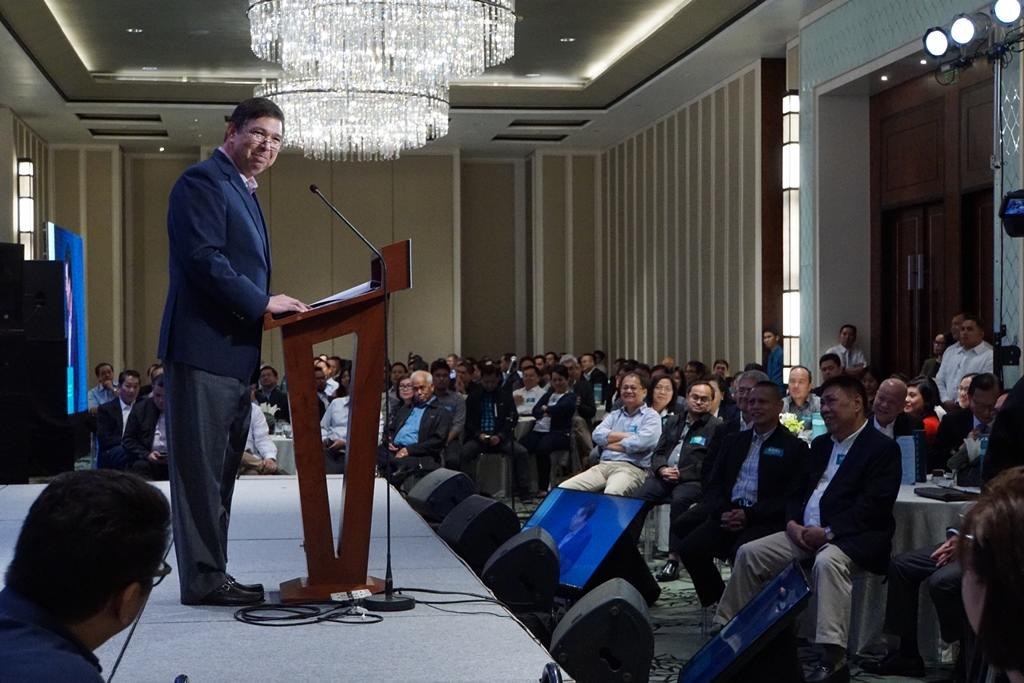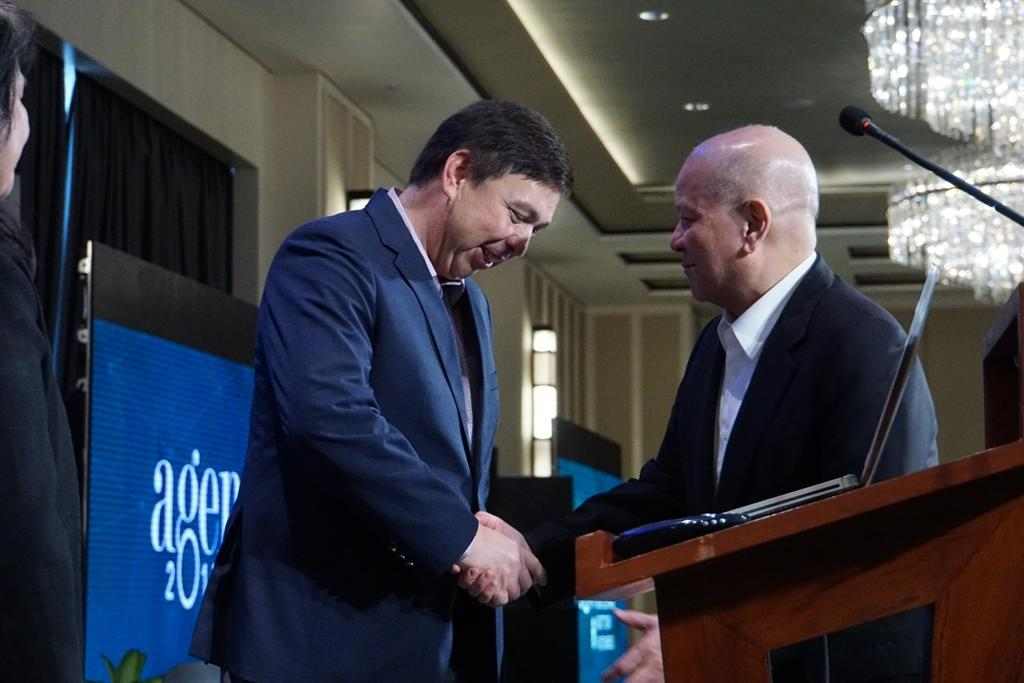The Future of Governance: Challenges and Opportunities”
Presentation of Senate Minority Leader Ralph G. Recto
SMC’s Agenda 2017: Building Better Futures
Makati Diamond Residences, 27 January 2017
Magandang umaga po sa inyong lahat.
It is my honor to be with the people who produce 4 percent of the GDP, and with Ramon who accounts for a bigger chunk.
To be honest, I am still wondering why you have invited a politician to this visioning exercise, knowing full well that instead of having a 20/20 vision, we are gifted with 20/20 hindsight.
If there’s one reason why it is taking us too long to reach prosperity, it is because the people we’ve elected to bring us there are more likely to play rearview mirror politics than to focus on the road ahead.
The result is that we’ve created a government which cannot see beyond three years. It treats five-year plans as either too long or too far into the future. And 20 years as an Ice Age.
Our planning cycle follows the election calendar, which means every 1,000 days. Projects are bookended by elections.
Government programs bear “best before election” completion dates so that when inaugurated, they can be milked for reelection purposes.
This has made us experts in the tactical, and proficient on the ad hoc. We love the quick-fix, and expect Band Aid cures to mature into permanent remedies. Ours is a government of instant gratification.
So instead of embarking on grand projects that would span several administrations, we content ourselves with piecemeal construction.
The tragic result of limited vision, and planning myopia, is chop-chop development and progress in small increments.
Kaya kung tatanungin ninyo ako kung ano ang numero unong balakid sa pamamahala ngayon, hindi ako babanggit ng personalidad o partido.
Ang aking isasagot ay isang uri ng kulturang kulang sa pananaw[,] at salat sa perspektiba. Isang kaugalian na matagal na nating sakit.
Sabi ko nga, hindi lang ad hoc—acrimonious na, acronymic pa.
Ano ang ibig sabihin nito? Lumang programa, bagong branding, often inspired by the acronym of the one on the throne, mapa-lokal man o nasyonal.
Kaya kung si RSA ang naging presidente, ang GMA rice program or Ginintuang Masaganang Ani would have been rebadged as Reliable and Sustainable Agriculture.
So I think good governance starts with imagining the future, going beyond the next elections, to how the next generations would fare.
But how can one start a serious national conversation on next-gen needs when this nerdy topic is boring for a people addicted to their daily supply of scandal?
When discourse is dominated by the salacious, the national DQ – or development quotient – of both the government and the governed suffers.
But we have to future-proof the country because it is changing every minute.
For example, I was given 20 minutes to speak, short by senatorial standards, and 20 minutes for the open forum.
By the end of these 40 minutes, 136 babies would have been born in this land.
In five years, if 120 of the 136 babies born in the next 40 minutes would knock on doors of public schools, then we should see to it that classrooms, teachers, books, and chairs are waiting for them.
Total cost: P4.5 million. Just for 120. By any yardstick, a big postpartum financial headache.
Isa pang halimbawa, paglaki ng mga iyan, mahihilig yan sa unli-rice, kasi nga may rice-loving gene in our DNA. Each Filipino on the average eats 119 kilos of rice annually.
The 136 Pinoys will thus devour 16.1 tons of rice yearly. To produce this, we have to open up 7 hectares of land to irrigation, the size of about 166 basketball courts, at a cost of P1.4 million.
Remember, kanin lang ‘yan ng babies produced in 40 minutes.
So what’s the impact of babies born in 10 minutes to public finances? About P1.5 million to accommodate them in kindergarten and P350,000 to irrigate the land required to grow the rice they would need.
Kaya lang, we birth babies in assembly line fashion.
For 2017, our population will grow by about 1.63 million. By 2020, there will be 109.26 million of us.
In ten years, there will be 120.1 million crowding this sliver of land that typhoons hit first but investors choose last.
We are adding the population of one Singapore every 3 years and 4 months. In 10 years, our population will grow by 17.5 million, or the population of Denmark, Finland and Norway.
I am rattling off these numbers not to give you Malthusian nightmares but to describe the additional constituency government must serve, and for SMC, the expanded customer base it can sell to.
So the challenge of governance today is to prepare for 17.5 million more Filipinos in the next decade, who must be fed, clothed, schooled, kept healthy, secured, and given jobs.
On rice, 17.5 million more mouths to feed means we have to ramp up rice supply by 2.1 million metric tons a year.
To achieve this, we can increase imports or irrigate more lands for rice production at a rate of 77,595 hectares – or more than three times the size of Camiguin – every year, until 2027.
On electricity, because per capita usage will rise to 1,100 kilowatt-hour annually by 2027, we have to commission the equivalent of two 100-megawatt plants every month for the next eight years.
Isang suggestion ko para makatulong ang Kongreso: Build a windmill in the Senate, and a methane gas plant in the House.
On schools, we will be needing 200,000 classrooms, 166,000 teachers, 3.8 million chairs and 57 million textbooks.
On water, because men bathe twice a day, and women thrice, and the car and the dog get shampooed too, we have to source, filter, and pipe in an additional 1.1 trillion liters of water a year by 2027.
On hospital beds, we have to ideally install 195,000 more by 2027, to wipe out backlogs and to meet future needs.
On roads, we have to build 20,000 new kilometers. Carmageddon is coming. Motor vehicle registration is projected to rev up from 14.4 million units last year to 25 million by 2027.
Di nakakapagtaka, as it has been computed that cars sold in Metro Manila in just four months last year could fill the entire length and all lanes of EDSA if the vehicles were parked bumper-to-bumper.
On airports, volume of air passengers is projected to soar from 45.3 million last year to 107.6 million by 2027, largely due to budget-friendly skies.
Its implication is obvious. We should have expanded our airports – yesterday. There is congestion above the airport – and around it. It was sometimes faster to fly across the ocean from NAIA than to drive to the flyover in SLEX. Ahem, buti na lang meron nang NAIA Expressway.
But on top of these, there are backlogs to be erased, across the infrastructure board. While ideally we should be building for the future, we are saddled with shortfalls from the past.
On roads, 156,553 kilometers remain unpaved. Concreting all of them would require P 1.88 trillion at a bargain price of P12 million per kilometer.
Because of how many we are, ours is the 40th biggest economy in the world.
Our consumption footprint is large, even on a per capita basis. Sa pagkain pa nga lang, alam mong dambuhalang merkado tayo.
Sa noodles nga lang, ang pambansang pagkain ng GNP – or Gutom na Pilipino – 34 na pakete kada taon ang hinihigop ng kada Pinoy, pampito sa buong mundo.
We imported 202 million metric tons of pork kasi mahilig tayo sa humba at adobo na hinaluan ng Lipitor.
Sa kape, we imported 104 million metric tons three years ago, not because we are addicted to caffeine, but because we love planners.
Pati sa isda, kulang na rin tayo. Labing-isang bilyong pisong halaga ang inangkat natin noong 2013, bago gawing fishpond ng mga Chinese ang karagatan natin.
Lampas P300 bilyon ang ating food import bill, yung deklarado, hindi kasama ang smuggled, tulad ng pinuslit na pusit.
Mahilig tayong uminom ng beer, almost 18 liters per person a year. San Mig Lights pa rin ang emperador ng inumin.
The list goes on and on.
Ano ba ang punto ko? Food production and rural development must remain national priorities. Agriculture absorbs 27 percent of jobs, and is home to the 40 percent of the poor. It is Ground Zero in the war against poverty.
Food eats up 60 percent of the budget of the bottom 30 percent of families, so keeping it affordable minimizes the pressure for wage hikes.
Kaya ang gusto ng tao makatikim ng murang pagkain at hindi lang mura mula sa Pangulo.
Ano pa ang isang punto ko? Philippines is a huge market. Kung base sa dami ng tao, it is the 12th biggest market in the world, at sa laki ng ekonomiya, nasa Top 40.
Our dashboard economic numbers are okay. Our GIR is $80.9 billion, which can finance 11 months’ worth of imports. Our debt-to-GDP ratio has been heading south for a long time.
There’s P8.9 trillion in bank deposit as mobilizable capital. While poverty numbers appear to have petrified, per capita income has more than doubled in a decade, from $1,522 in 2005 to $3,483 in 2015.
But I am here not to tick off a grocery list, but to prescribe to-dos in the field of governance.
I have listed down five challenges.
First is for government to have a national plan, and make its realization the national purpose.
At present, the only tally we’re making concerns body bags. While there are important numbers to track, the national scoreboard shows only deaths.
Any government fails its people when it hews to a singular narrative alone.
With a plethora of problems confronting the nation, no government can afford to be a single-issue one, unless it is trying to hide its inability to multitask because its talent is overwhelmed by the tasks at hand.
What are the numbers that should matter most to us, against which government’s performance must be primarily measured?
These are poverty and employment.
Between 2016 and 2022, the government said it will create 12 million jobs, or 2 million a year – quality jobs, hindi yung nagpastol ka lang ng isang kambing, counted ka na as gainfully-employed.
Ang isa pang target ay ang pag-gradweyt sa kahirapan ng 7.1 million Pinoys sa 2022. Mula 21.9 million poor noong nakaraang taon, pababain ito sa 14.8 million sa 2022.
If there’s a more important kill list – then it is to slay poverty and joblessness.
How to hit these two targets, the strategies to be employed, are spelled out in the 2017-2022 Philippine Development Plan which NEDA has prepared.
Once launched by President Duterte next month, it will become a roadmap, a Waze, that will guide us toward our development goals.
If government won’t allow us to build a house without a plan, then all the more that we should require government to have a plan in building the nation’s future.
As the national blueprint, the PDP is the spring from which sectoral and regional plans will flow. Even the national budget is an annual expression of the plan’s goals.
Kung meron nang menu of projects, lalo na sa infrastructure, this will reduce opportunities for that legislative livelihood program called “pork entrepreneurship.”
If we have a plan, then we are armed with forward estimates of the things we should build and acquire. A plan does not only tag the priorities but the price tag of each.
As we enter a very taxing season, a plan will give us an idea of the magnitude of future spending, so we will know how much really the government wants from us in taxes.
A plan is an antidote to overbilling. It stops government from being intaxicated, which is worse than being drunk with power.
I know that the plan is couched in boring language.
So my suggestion is for government to popularize, laymanize, market the targets of the plan, to give it the Mocha effect, and the millennial appeal, and banner each as national goals which we all must work for.
This was done before in the past. Remember Masagana 99?
Second is for government to think big and bold.
We must have a “man on the moon” goal. I am referring to Kennedy’s vow to put a man on the moon before the 60s was over.
We must break free of the political culture which treats grandiose dreams as grandstanding.
Huwag tayo magtipid sa ambisyon. We may be in the gutter, but let us fix our gaze at the stars.
Instead of raising the bar, we opt for the least common denominator. So para sa akin yung planong Mindanao railways, airport in Manila Bay, bridge to Mindanao, Manila Subway, ituloy ‘yan, because it is good for a national psyche that celebrates smallness.
Punta kang Hong Kong today, malapit nang matapos ang Kowloon to Macau bridge; tayo plano pa lang ng dagdag na tulay across the Pasig River.
Morocco is about to get its first bullet train. Tayo ang debate hanggang escalator pa lang ng MRT.
Sa isang SONA ni PNoy, ano ang binida na science invention? Mosquito trap made out of an empty can, at a time when a Malaysian was orbiting in Space.
While China is turning atolls into airports, we are having a hard time building waiting-shed sized barangay clinics. We’re two years delayed in building 66,463 classrooms.
But not all solutions require concrete; some involve a small dash of common sense. Let not big dreams lull us into ignoring the doable.
Ang ganda ng mga Powerpoints “to maximize carriage capacity of NCR roads by removing obstructions.”
Bakit hindi na lang gamitin ang P13 billion annual collection ng Road Users Tax para bumili ng 100 tow trucks at a cost of P200 million para cleared kaagad ang kalsada na pinaradahan ng junk na kotse?
May problema sa quality of math education.
One temporary solution: Get experts to develop a syllabus, tap a great and telegenic teacher, and break up the lessons in several YouTube episodes.
The third is for a smart but small government to simplify its rules and streamline its operations.
Digong may have tamed the Reds but not red tape.
On opportunity losses for SMEs alone, red tape costs us P140 billion a year, sabi ng World Bank. We rank a low 95th in overall ease of doing business.
The culprit? The Byzantine maze of regulations in a Balkanized bureaucracy.
Walk-in ka sa casa, with only your handsome face as collateral, in 72 hours, your P1 million loan application will be approved.
Go to PAGIBIG with a land title worth P2 million as collateral for a P1.6 million loan and it will take you weeks and tons of paperwork to get an approval. Ang kotse pwede mo itakbo, ang lupa hindi.
Many small transactions require physical appearance. If you have a hacienda in Basilan, you cannot wire RPT payments, nor can you make advance payments for the coming year.
If you’re a freelance writer, you get a business permit, but to get one, you need a fire clearance, when you’re still freeloading at your parents’ home and you do your work in that corporate headquarters of the Facebook generation called Starbucks.
Pag-na-approve ang business permit magbabayad ka ng plaka, na may Photoshopped picture ni Mayor, habang ang plaka ng Vios mo taon nang wala.
Kung nagkataong pasok ka sa VAT bracket, you have to make 36 annual pilgrimages to the BIR.
In getting government documents, we have to shorten the process, shrink the number of requirements and signatories, and speed up the delivery, and price them in a way mandated by law: to recover the cost in making them but not to make a profit.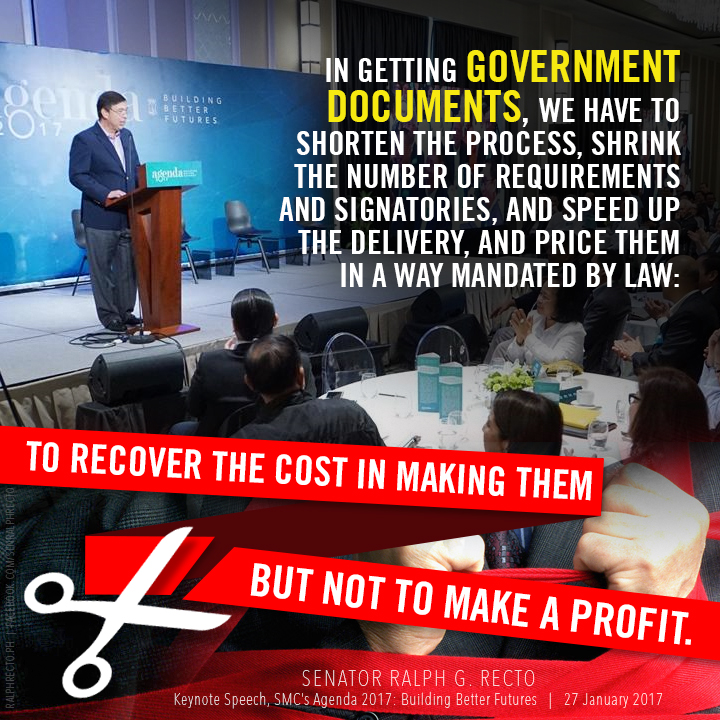
Kung ang pizza hindi dumating in 30 minutes, libre na, bakit ang reimbursement ng bayad sa phantom plates wala pa?
We have to lengthen the validity of licenses, permits, passports, NSO clearances, and make it transactable online.
For big-ticket items like PPPs, more one-stop shops and clear and unchanging rules. Minsan kasi ang transparency cost mas malaki pa sa moral hazards na iniiwasan. Exhibit A: MRT.
In all of this, we must harness ICT.
Kahit ang public hospitals natin, i-mandate na mag-telemedicine.
Permits, licenses, land titles should now be electronically-applied for, processed and issued. Let us leave to the MRT the exclusive franchise of organizing long lines.
But this would require reforms in the telecoms sector, because what use is online application forms when it downloads pixel by pixel in Tetris speed?
We must reduce the bloat in our bureaucracy.
Government payroll is now P1 trillion a year, from P500 billion seven years ago.
Another cost needle that is moving up is overhead.
One solution is the merger of agencies, even political units, and even abolition of some. In the case of state colleges and universities, an experiment to merge them into a regional university system.
A moratorium in the creation of provinces must be put in place. And study the fusion of barangays and towns.
Every 1,000 days we hire, through costly elections, 12 senators, 292 congressmen, 81 governors and vice governors, 144 city mayors and vice mayors, 1,490 town mayors and vice mayors, 13,476 town councilors.
In addition, we have a total of 672,576 elected barangay and SK officials.
By reducing the membership of all legislative bodies by just one, P4 billon annually could be saved, per one estimate.
We are nearing “peak law.” There are more than 1 million PDs, EOs, RAs, MCs, DAOs, LGU ordinances that choke us.
Tapos, under federalism, may balak pang maghalal ng 81 regional senators at 292 representatives.
Technology and good roads have shrunk the world. You can now talk, text and troll your representative. Dati you had to personally kalabit your congressman. Now you can poke him in FB.
Fourth is about innovation and incubation of best practices and prototypes.
Government must promote excellence. Kung merong magandang halimbawa, ipakalat agad. We must standardize quality.
Iba’t iba ang design ng schoolbuildings. Hanggang ngayon walang 2.0 version ng BLISS or walk-up condos. In a typhoon-plagued country, we still do not have a stock design for emergency shelter.
In procurement, we must never tire in improving models that comply with the law, that speed up the process but don’t leave the government shortchanged.
Sa kalsada, riot ang style ng lamppost.
Here, the size of business permit plates is as small as chocolate bar. There, it is as big as a cartolina. From NAIA to Ortigas, you have to pass through 5 LGUs, with different traffic codes and fines.
Pati emergency hotlines iba. Dial 911 dati, pizza delivery sasagot. Ano ito? Carry over ng tribal past natin.
Ganoon din ang rail system. Chop chop. Kaya nga natagalan magawa ang Common Sense Station, di ba?
Let me make a detour here. The 196-kilometer Manila-Dagupan line was completed in five years in 1891. One section, the 76-kilometer Tarlac to Dagupan, was completed in six months, in the midst of the typhoon season.
It took three days to lay a kilometer of track 122 years ago. Today, it takes months for one rail-related document to move from one table to another.
If one LGU had stumbled on a good app, replicate it.
We must fund research, encourage invention, and technology incubation sites. Kailangan ng barko for coastal patrol? Let Cebu builders do it. Ganoon din sa baril. Tap local manufacturers, for interoperability.
Fifth is about the imperatives of competence and compassion.
A nation’s progress depends on the quality of its human capital. Education dictates whether it prospers or it remains poor.
The battle for the future is being waged in classrooms of today.
But building the country’s talent pool is not the responsibility of families alone. Government must provide equity.
We can economize in all things except education. What government spends for schools are not unrecoverable expenses but investments with high returns.
To modernize our country, we have to modernize our schools first.
Kahit naman sa San Miguel, people are your number one asset. But you can only keep getting good people if the country keeps on developing excellent human capital.
Hindi pwedeng kulelat tayo sa math and science – 79th sa buong mundo . We must produce more technicians than trolls.
We must also tailor higher education to what is required by our economy. The job mismatch is glaring.
Halimbawa, noong 2013, 27,196 ang pumasa sa board exam for nurses, ngunit 113 lang na aeronautical engineers.
We produced 949 lawyers in 2012 despite the glut in courtrooms, but only 10 professional mining engineers despite the mining boom.
Ang resulta tuloy ay nag-uumapaw tayo sa abogado, pero kulang ang lisensyadong tubero.
We must focus on education. And it will get the attention it deserves if the president has a variance of advocacies and begins wearing many hats. Ang isa dito: Maging teacher-in-chief.
We can’t have a national leadership with attention deficit disorder in other issues. I mentioned compassion because at a time when then rule of law is shortcircuited and judicial shortcuts are encouraged, we have to reclaim our moral bearings as a people.
It is not enough that we retain and increase the welfare armor programs that we have, like 4Ps, old-age pension and the like, but in all aspects that can lead to the building of a kinder society based on civility, fairness, and justice.
Isang lipunang may tunay na malasakit.
Malaki ang papel ng San Miguel diyan. You labor under the rich and proud heritage of solidarity with our people, accumulated through more than a hundred years of existence, of profit with honor.
Tulad nga ngayon ang biro ko kay Ramon, ibang klase din ang CSR mo: NAIA Expressway, SLEX connector, MRT 7. Abono lahat at hindi ka pa nababayaran. Nag-advance ka pa ng premium.
Kayo lang ang may sunk in the ground projects. Ang iba maingay lang. You let your construction equipment do the talking.
But I am not surprised because it is in your DNA to dream big, build boldly, to blaze new trails.


